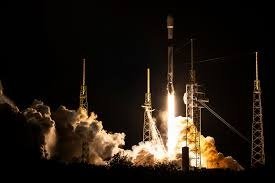Washington: SpaceX has kicked off the year 2025 by successfully launching its first Falcon 9 rocket, marking the beginning of global orbital launches for the year. The Falcon 9 rocket took off on January 3 at 8:27 PM EST (0127 GMT) from Space Launch Complex 40 at the Cape Canaveral Space Force Station in Florida, carrying the Thuraya 4 satellite into geosynchronous orbit.

Thuraya 4 Satellite: A Key Asset for Europe, Middle East, and Africa
The Thuraya 4 satellite is operated by Space42, a satellite and space services company based in the United Arab Emirates. This satellite is designed to provide mobile communication services to commercial and government clients across Europe, the Middle East, and Africa. Its launch is expected to improve connectivity in regions where traditional communication networks are less accessible, enhancing communication capabilities across vast areas.
Successful Landing of Falcon 9 Booster
Just 8 minutes and 40 seconds after liftoff, the Falcon 9 booster returned to Earth and successfully landed on SpaceX’s drone ship, *A Shortfall of Gravitas*, located offshore in the Atlantic Ocean. This marked the 20th successful flight and recovery of the Falcon 9’s first-stage booster, bringing SpaceX’s total orbital-class rocket recoveries to 341, which includes both Falcon 9 and Falcon Heavy boosters.
Other Key Milestones of the Mission
In addition to the Thuraya 4 satellite, the Falcon 9 booster was also responsible for launching the iSpace HAKUTO-R lunar lander to the Moon’s surface, an International Space Station (ISS) resupply mission, and the 13th batch of SpaceX’s Starlink satellites. About 35 minutes and 30 seconds after liftoff, the Thuraya 4 satellite was deployed into a Geostationary Transfer Orbit (GTO), from where it will begin the process of reaching geosynchronous orbit, directly above a fixed position on Earth.
SpaceX’s Achievements and Upcoming Missions
The Thuraya 4 mission marked the 418th flight of SpaceX’s Falcon 9 rocket and the company’s 435th overall mission. SpaceX launched over 130 orbital missions in 2024, and the company expects to exceed this number in 2025 with a record number of launches.
Thuraya 4-NGS: Advanced Technology for Next-Generation Communication
The satellite launched in this mission is officially known as *Thuraya 4-NGS* (Next Generation System), which was built by Airbus. The satellite is equipped with state-of-the-art technologies that will offer advanced communication services. According to Ali Al Hashmi, CEO of Yahsat Space Services, one of the companies that operates Space42, the satellite’s technology will “unlock the latest AI-driven services,” providing consumers with faster and more reliable mobile communication services.









